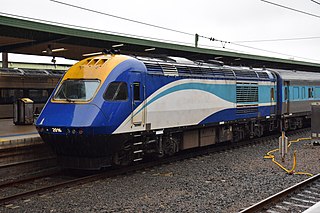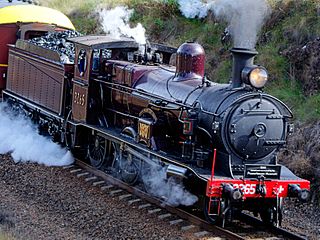
Harden–Murrumburrah is a township and community in the Hilltops Region and is located in the South West Slopes of New South Wales in Australia. Harden is adjacent to both the Canberra region of the Australian Capital Territory and the Riverina Region in the southwest area of NSW. The town is a twin town between Harden and Murrumburrah.

CountryLink was a passenger rail and road service brand that operated in regional areas of New South Wales, and to and from Canberra, Brisbane and Melbourne. Originally created as a business unit of the State Rail Authority of New South Wales, it later became a subsidiary of RailCorp. CountryLink operated rail services using XPT and Xplorer rolling stock, with connecting coach services operated under contract by private operators.

The Australian state of New South Wales has an extensive network of railways, which were integral to the growth and development of the state. The vast majority of railway lines were government built and operated, but there were also several private railways, some of which operate to this day.

The Main North Line is a major railway in New South Wales, Australia. It runs through Strathfield to Armidale. The line is the main line between Sydney and Armidale. As of 1988, the line closed progressively north of Armidale with services gradually withdrawn till 2004, with the main route between Sydney and Brisbane now the North Coast line. The end of these services marked a significant shift in rail transport in the region, leading to an increased reliance on road transport and altering the dynamics of movement and passenger accessibility between these major cities..
Berlei is a brand of women's lingerie and in particular bras and girdles.

Mittagong is a town located in the Southern Highlands of New South Wales, Australia, in Wingecarribee Shire. The town acts as the gateway to the Southern Highlands when coming from Sydney. Mittagong is situated at an elevation of 635 metres (2,083 ft). The town is close to Bowral, Berrima, Moss Vale and the Northern Villages such as Yerrinbool and Colo Vale. Moreover, Mittagong is home to many wineries of the Southern Highlands which has been a recent growing wine and cellar door region.

The Southern Highlands Line (SHL) is an intercity rail service that services the Macarthur, Southern Highlands and Southern Tablelands regions of New South Wales. First operating in 1869, the service runs from Campbelltown across the Main Southern railway line through to Goulburn, with peak hour services extending the route to Central. The railway service operates alongside a bus route from Picton to Bowral, operating on the route of the Picton – Mittagong loop railway line, and a regional coach service from Bundanoon to Wollongong on the South Coast Line, operating on the corridor of the Unanderra–Moss Vale railway line.

The North Coast railway line is the primary rail route in the Mid North Coast and Northern Rivers regions of New South Wales, Australia, and forms a major part of the Sydney–Brisbane rail corridor.

The Lachlan Valley Railway Society is an Australian rail preservation society based in the New South Wales Central Western town of Cowra. It was established in 1974 to preserve and operate former New South Wales Government Railways locomotives and rolling stock. It operates regular heritage train tours to a variety of locations across New South Wales.

Canberra railway station is located on the NSW TrainLink Regional Southern Line in the Australian Capital Territory, Australia. It is located in the Canberra suburb of Kingston.

The Main Southern Railway is a major railway in New South Wales, Australia. It runs from Sydney to Albury, near the Victorian border. The line passes through the Southern Highlands, Southern Tablelands, South West Slopes and Riverina regions.
The New Zealand cricket team toured Australia from early December 1925 to mid-January 1926, playing four first-class matches against state teams and five other matches.
The railways of New South Wales, Australia, use a large variety of passenger and freight rolling stock. The first railway in Sydney was opened in 1855 between Sydney and Granville, now a suburb of Sydney but then a major agricultural centre. The railway formed the basis of the New South Wales Government Railways. Passenger and freight services were operated from the beginning. By 1880, there was a half hourly service to Homebush.

The Crookwell railway line is a disused branch railway line in the south of New South Wales, Australia. Although it has never officially been closed, the line has not seen services since the late 1980s. It branched from the Main South line at North Goulburn and passed north through the localities of Kenmore and Roslyn to the town of Crookwell. As of 2020, there were proposals to convert the line into a rail trail.

The New South Wales XPT is a class of diesel-powered passenger trains built by Comeng and ABB. Based on the British Rail-designed High Speed Train, each XPT set comprises two XP power cars in a push-pull configuration and, between them, between four and seven passenger carriages.

The Taralga railway line is a disused branch railway line in the south of New South Wales, Australia. The line commenced at Roslyn and split off the Crookwell railway line to then run to the small town of Taralga. The line operated between 1926 and 1957 and is one of few lines in New South Wales that has been formally closed by an Act of Parliament. Today all track has been lifted and little trace remains of the infrastructure associated with the line.

3265 is a preserved former New South Wales Government Railways C32 class steam locomotive. Built in 1902 by Beyer, Peacock & Company, England, it is owned by the Powerhouse Museum and based at the NSW Rail Museum, Thirlmere.
Cycling in the Australian state of New South Wales is a common form of recreation.

NSW TrainLink is a train and coach operator in Australia, providing services throughout New South Wales and the Australian Capital Territory, along with limited interstate services into Victoria, Queensland and South Australia. Its primary intercity and regional services are spread throughout five major rail lines, operating out of Sydney's Central railway station.
The 1954 Great Britain Lions tour was a tour by the Great Britain national rugby league team of Australia and New Zealand which took place between May and August 1954. Captained by Dickie Williams, the tour involved a schedule of 32 games: 22 in Australia and 10 in New Zealand, with two three-match Test Series against both nations.
The tour began inauspiciously, with Great Britain losing four of their first seven matches, including the First Test against Australia in Sydney. Moving into the Queensland leg, the Lions' results improved, and they won all nine of their matches in the state. This included victory in the Second Test in Brisbane.
A common feature of many of the tour matches was rough play, punches being throw in and out of tackles. The July 10 match against New South Wales was abandoned by the referee seventeen minutes into the second half due to persistent brawling by the players.
One week after the abandoned game, Australia won the Third Test to claim the Ashes by a 2–1 margin.
Moving to New Zealand, Great Britain lost the Second Test, but recovered to win the Third Test and the series, by a 2–1 margin.
The tour concluded with three matches in five days back in Australia at Sydney, Canberra and Maitland.
Despite being a British team – five of the squad were Welsh, two from Scotland and hooker Tom McKinney from Northern Ireland – the team played, and were often referred to by both the press at home and away, as England.















